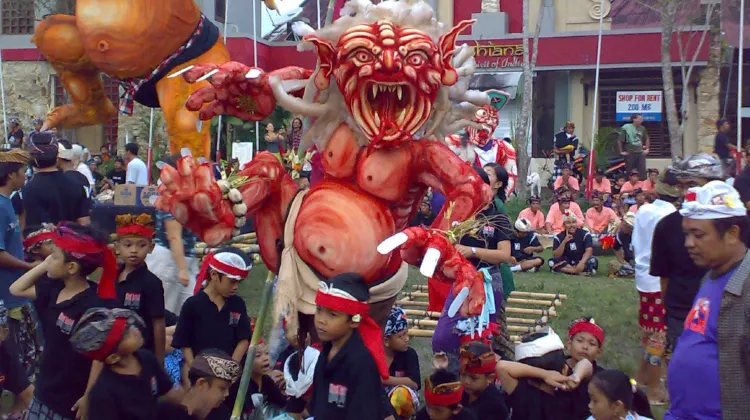Hey there, fellow traveler! Are you dreaming of visiting Bali but not sure when is the best time to go? Do you want to enjoy the sun, sand, and surf without worrying about rain or crowds? If so, you’ve come to the right place. In this article, I’m going to share with you everything you need to know about the weather in Bali, one of the most popular destinations in Indonesia and Southeast Asia. If you're looking for in-depth insight, check out our travelers guide to flying to Bali!
Did you know that Bali attracts more than 6 million visitors every year? And that it has an average temperature of 27°C (81°F) throughout the year? Sounds amazing, right? Well, there’s more to Bali’s weather than meets the eye.
So keep reading and find out how to plan your trip to Bali based on the weather and have an unforgettable experience in this tropical paradise.

The Uma Pakel Swing is a must-do activity during the warmer seasons!~
Overview of Bali's climate and seasons
Bali has a tropical climate, which means it is hot and humid all year round. The average temperature is around 27°C (81°F), but it can vary depending on the altitude and the location. The coastal areas are usually warmer and drier than the inland areas, which are cooler and wetter.
Bali has two main seasons: the dry season and the wet season. The dry season runs from April to October, while the wet season runs from November to March. However, these seasons are not very distinct, as Bali can experience rain or sunshine at any time of the year.
The dry season is generally considered the best time to visit Bali, as it has less rainfall, lower humidity, and cooler breezes. The weather is ideal for outdoor activities, such as surfing, diving, hiking, sightseeing, etc. However, the dry season also coincides with the high season, which means Bali can get very crowded and expensive during this time.
The wet season is usually avoided by most travelers, as it has more rainfall, higher humidity, and hotter temperatures. The weather can be unpredictable and change quickly, from sunny to cloudy to rainy. The rain can cause floods, landslides, and traffic jams in some areas. However, the wet season also has some advantages, such as fewer tourists, lower prices, and greener scenery. The rain usually falls in short bursts in the afternoon or evening, leaving plenty of time for enjoying the sun and the beach.
Here is a table that shows the average temperature, rainfall, and sunshine hours in Bali throughout the year:
| Month | Average Temperature (°C/°F) | Average Rainfall (mm/in) | Average Sunshine Hours |
| January | 26/79 | 347/14 | 6 |
| February | 26/79 | 285/11 | 7 |
| March | 27/81 | 214/8 | 8 |
| April | 27/81 | 94/4 | 9 |
| May | 28/82 | 76/3 | 9 |
| June | 27/81 | 70/3 | 10 |
| July | 26/79 | 56/2 | 10 |
| August | 26/79 | 23/1 | 10 |
| September | 27/81 | 66/3 | 10 |
| October | 27/81 | 147/6 | 9 |
| November | 27/81 | 197/8 | 8 |
| December | 26/79 | 295/12 | 6 |
As you can see, Bali's weather varies throughout the year, but it never gets too cold or too hot. However, the weather also affects the landscape and nature of Bali, such as the rice terraces, the volcanoes, the beaches, etc.
Best time to visit Bali based on the weather
There is no one best time to visit Bali as it depends on your personal preferences and goals. However, by knowing how the weather changes throughout the year and what are the advantages and disadvantages of each season, you can make an informed decision and plan your trip accordingly.
Here are some factors that you should consider when choosing the best time to visit Bali based on the weather:
What kind of activities or experiences are you looking for?
Do you want to surf, dive, hike, sightsee, or relax on the beach? Different activities require different weather conditions and sea levels. For example, surfing is best from April to October when the waves are bigger and more consistent on the west coast of Bali. Diving is best from May to November when the water is clearer and calmer on the east coast of Bali. Hiking is best from June to September when the weather is cooler and drier on the mountains of Bali. Sightseeing is best from April to October when the weather is sunny and dry on most parts of Bali. Relaxing on the beach is possible all year round as long as you don't mind some occasional rain or clouds.
What kind of events or festivals do you want to attend or avoid?
Bali has a rich culture and tradition that is reflected in its many events and festivals throughout the year. Some of these events are religious or cultural celebrations that attract many locals and tourists alike. Others are music or art festivals that showcase local and international talents and performances. Depending on your interest and preference, you may want to join or avoid these events and festivals. For example,
Nyepi:
This is the Balinese New Year that falls in March or April every year. It is a day of silence and meditation where no one is allowed to work, travel, or make noise. The night before Nyepi, there are colorful parades of giant paper-mache monsters called ogoh-ogoh that symbolize evil spirits. Nyepi is a unique experience that can be either fascinating or frustrating for travelers.

The streets of Bali are calm and quiet on Nyepi, as locals gather together, young and old, to celebrate "The Day of Silence". Image credits to Wikipedia.
Galungan:
This is a Hindu celebration that occurs every 210 days according to the Balinese calendar. It marks the victory of good over evil. During Galungan, the streets are decorated with bamboo poles called penjor that have offerings hanging from them. There are also ceremonies, dances, and feasts in temples and villages. Galungan is a festive time that showcases the Balinese culture and spirituality.
Bali Arts Festival:
This is an annual event that takes place from June to July in Denpasar,the capital city of Bali. It features various performances, exhibitions, competitions, workshops, and parades of Balinese arts such as music, dance, drama, puppetry, painting, sculpture, etc. It is a great opportunity to witness the diversity and creativity of Balinese artists.

Experience the rich culture of Balinese history during the Bali Arts Festival~
How much do you care about crowds or prices?
Bali is a popular destination that attracts millions of visitors every year. However, some months or seasons are busier than others. Generally speaking, the high season in Bali coincides with the dry season especially from July to August when many people from Europe and Australia come for their summer holidays. The high season also includes major holidays such as Easter, Christmas, New Year, Chinese New Year, etc. During these times, Bali can get very crowded and expensive, as hotels, flights, tours, etc. raise their prices significantly. If you want to avoid crowds or save money, you may want to visit Bali during the low season, which coincides with the wet season, especially from January to March when fewer people visit Bali. The low season also offers more discounts and promotions for accommodation, transportation, activities,etc. However, you may have to deal with more rain or clouds during this time.
Here is a table that shows the best and worst months for different activities in Bali based on the weather and other factors:
| Activity | Best Months | Worst Months |
| Surfing | April - October | November - March |
| Diving | May - November | December - April |
| Hiking | June - September | December - March |
| Sightseeing | April - October | November - March |
| Relaxing | Anytime | Anytime |
Tips for traveling to Bali in different weather conditions
No matter when you decide to visit Bali, you can always have a great time if you follow some tips and advice for traveling in different weather conditions. Here are some of them:
What to pack:
Packing for Bali can be tricky as you need to be prepared for both hot and rainy weather. Some essentials that you should bring include:
- Lightweight clothing made of cotton or linen that can keep you cool and comfortable.
- Sunscreen, sunglasses, and hat to protect yourself from the sun.
- Raincoat, umbrella, and waterproof bag to protect yourself from the rain.
- Swimwear, towel, and flip-flops to enjoy the beach and the pool.
- Hiking shoes, socks, and backpack to explore the mountains and the jungle.
- Sarong, scarf, and modest clothing to visit the temples and respect the local culture.
How to avoid crowds:
Bali can get very crowded during the high season or major holidays. If you want to avoid crowds, you can try some of these tips:
- Visit Bali during the low season or mid-season when there are fewer tourists and lower prices.
- Avoid popular tourist areas such as Kuta, Legian, Seminyak, and Canggu and explore less-known areas such as Amed, Lovina, Sidemen, and Munduk.
- Wake up early and visit the attractions before they get busy or visit them late in the afternoon when they get less busy.
- Book your accommodation, transportation, tours, etc. in advance to secure your spot and avoid disappointment.
How to deal with rain or heat:
Bali can have unpredictable weather that can change quickly from sunny to cloudy to rainy. If you want to deal with rain or heat, you can try some of these tips:
- Check the weather forecast before you plan your day and be flexible with your itinerary. You can use apps or websites such as AccuWeather or MSN Weather that provide reliable and updated weather information for Bali.
- Stay hydrated and drink plenty of water or coconut water to avoid dehydration or heatstroke. You can also eat fruits or ice cream to cool down.
- Seek shade and avoid direct exposure to the sun during the hottest hours of the day (between 10 am and 4 pm). You can also use air conditioning or fans to keep yourself cool.
- Enjoy indoor activities such as shopping, spa, museum, cinema, etc. when it rains or when it's too hot outside. You can also use this time to relax or nap in your hotel or villa.
Plan ahead based on the weather and enjoy the full experience of Bali today!
As you can see, there is no one best time to visit Bali as it depends on your personal preferences and goals. However, by knowing how the weather changes throughout the year and what are the advantages and disadvantages of each season, you can make an informed decision and plan your trip accordingly.
Bali is waiting for you with its stunning scenery, rich culture, and friendly people. Whether you want to relax on the beach, explore the jungle, or immerse yourself in the local traditions, you will find something for everyone in Bali.
So what are you waiting for? Book your trip to Bali with Trip.com today and get ready for an amazing adventure in this tropical paradise.
Weather in Bali
What is the best time to visit Bali?
The best time to visit Bali is during the dry season, which runs from April to October.What is the weather like in Bali?
Bali has a tropical climate with an average temperature of 27°C (81°F) throughout the year. The coastal areas are warmer.Does Bali have distinct seasons?
Yes, Bali has two main seasons: the dry season (April to October) and the wet season (November to March).Is it crowded during the dry season?
Yes, the dry season coincides with the high season, so Bali can get crowded. However, it also offers ideal weather for outdoor activities.What are the advantages of the wet season?
The wet season in Bali offers fewer tourists, lower prices, and greener scenery. It's a good time for budget travelers and nature lovers.What activities are best during the dry season?
Surfing, diving, hiking, and sightseeing are popular activities during the dry season.Is it possible to relax on the beach throughout the year?
Yes, you can relax on the beach in Bali all year round, but expect occasional rain or clouds.Which months are best for surfing?
The best months for surfing in Bali are from April to October when the waves are bigger and more consistent.Are there any unique events or festivals?
Yes, Bali has events like Nyepi (Balinese New Year) and Galungan (Hindu celebration) that offer unique cultural experiences.When is the low season in Bali?
The low season in Bali is during the wet season, especially from January to March.
